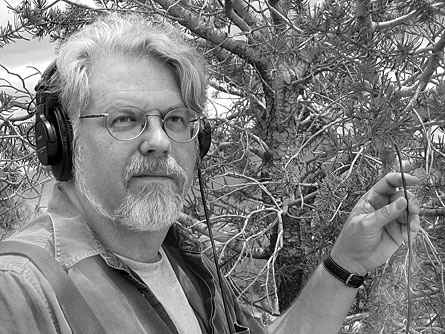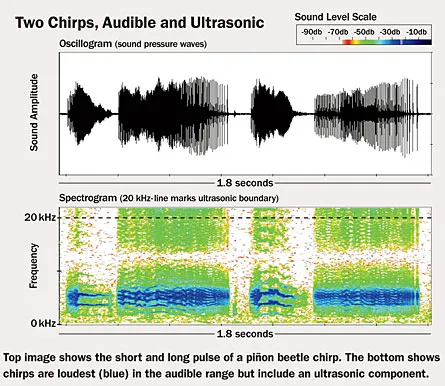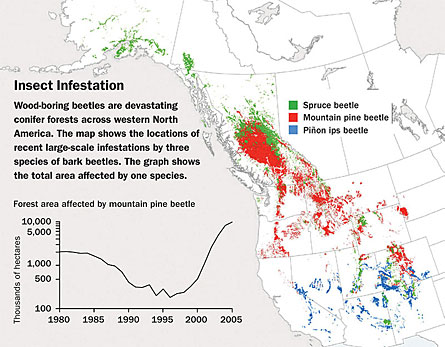Pop chirp bite crunch chew
The ultrasonic din of dying trees inspires a new kind of research to save forests from beetle attacks — and battle climate change
Normal 0 false false false MicrosoftInternetExplorer4
It turns out that a tree doesn’t have to fall in the forest to make a sound. Upright trees make plenty of sounds, even though human ears can’t hear them. But few aside from botanists would have known about the voices of the trees if two guys had not pounded an old meat thermometer turned ultrasonic microphone into a beetle-infested pi±on.



When they did, composer David Dunn and physicist Jim Crutchfield heard “sounds that went on, uninterrupted, for long periods of time. It was a constant ultrasound, and it didn’t matter where you were, the sound was there,” Crutchfield says. “It was bizarre.”
The cacophony came from a tree besieged by drought — and from a frenzy of tree-invading beetles.
The duo’s investigation began after Crutchfield’s New Mexican pi±on pine trees came under attack.
“I had to cut down 100 trees on my lot,” he says, “and I wanted to know what killed them.”
It was not the drought that ultimately destroyed the pines but the invasion of a specific type of bark beetle and its accompanying fungus. Crutchfield’s neighbors turned to pesticides to thwart the insect attack, but had no luck. The trees still died.
The same destruction has been happening — en masse — elsewhere as well. The spruce bark beetle has already taken a Connecticut-sized bite out of Alaskan pine forest. And bark beetle outbreaks have desolated thousands of square kilometers of western North American forests, incidentally releasing thousands of tons of carbon into the atmosphere. The additional carbon is a concern because of its link to climate change.
But it was the tree deaths and the failure of the pesticides that first led Crutchfield, who models complex chaotic systems at the University of California, Davis, and Dunn to propose a radical solution to dampen beetle infestations: They want to play deceptive ultrasound to confuse the tree-devouring bugs, luring them away from vulnerable forests and keeping the insects from spreading to new territories.
Crutchfield says the noise could perhaps even stop the beetles from inadvertently adding so much carbon to the air that humans’ contributions to global warming would become irrelevant.
The big crunch
The idea to use ultrasound as a beetle-defense tactic began percolating in the pair’s minds about four years ago. As Crutchfield’s trees were dying, Dunn, who is president of the Art and Science Laboratory in Santa Fe, N.M., was fabricating a device to listen to the ultrasonic sounds of nature. The environmental sound recordist had decided to create a high-frequency recorder while working at the Detroit Zoo, where he learned that endangered Tanzanian frogs used ultrasonic calls to find mates.
Dunn and Crutchfield got together to eavesdrop on pine trees and their invading beetles, which led the composer to an idea. He wondered if the beetles could, in any way, detect the ultrasound coming from the trees. As the pines’ liquid- transporting cells dehydrate, the trees’ water columns cave in, creating ultrasonic pops. Scientists believe that extended periods of dehydration and drought cause the water cells to implode and give off the pops, which are near the 100 to 300 kilohertz range. By comparison, the highest frequency a human can hear is 20 kilohertz.
Crutchfield suggests that the pops may help possible beetle invaders sense whether a tree is ripe for attack and whether they should chomp through to its inner living layers to lay eggs. Healthy trees have a defense against this invasion, he says. By secreting a sticky, toxic ooze, or resin, that flows into the holes beetles bore into the bark, the pines can “pitch out” the insects.
Drought-stressed trees affected by warming temperatures and consequent moisture loss, though, have trouble making the defensive resin to push the beetles out of the bark. And, water-deprived trees, Crutchfield says, generate more ultrasonic pops. So as the beetles successfully chew their way through a tree, they could pick up the sounds of the tree’s cells collapsing.
Amid the popping, Dunn and Crutchfield also picked up on loud, piercing ultrasonic chirps — the beetles’ cries — as well as crunches on the bark. Beetles passing by might hear the crackles, crunches and pops and drop by to get a bite of their own, the physicist says.
“This hypothesis, namely that trees send signals to beetles, needs a lot of experimental work to back it up,” Crutchfield concedes. “It’s difficult to study because, to take one example, no one knows what the insect’s hearing mechanism is or even if it is responding to ultrasound.”
Wood-boring beetles do seem to sense which trees are more vulnerable to attack, but scientists do not yet know how. The mountain pine beetle reacts strongly to chemicals called pheromones that are produced by the insects during their attacks, as well as to kairomones, aromatic compounds produced by the trees, says James Powell, a mathematician from UtahStateUniversity in Logan who models the dynamics of beetle invasions in pine forests.
Most entomologists think beetles rely primarily on pheromones, not sound, to communicate, mate and possibly even rally the troops for invasion. Powell has studied the interaction between beetles and pine forests in the Rockies, and he says countering beetle outbreaks with chemicals is hit or miss. Some experiments in Scandinavia have actually shown that using pheromones to lure beetles away from vulnerable trees can exacerbate beetle invasion, Crutchfield says.
Crutchfield and Dunn published their “bioacoustic ecology hypothesis” in 2006 as a working paper on the website of the Santa Fe Institute, a center for interdisciplinary research. A revised version will appear in an upcoming Leonardo, a journal highlighting work of artists using science- and technology-based media.
Despite all the existing research on beetle communication, Crutchfield says, entomologists don’t yet know how far each species’s chemical or sound signals can travel.
It’s also not known what actually kills a tree after a beetle infestation. Richard Hofstetter, Crutchfield’s collaborator and an ecologist at NorthernArizonaUniversity in Flagstaff, has a beetle farm and looks at the interactions between beetles and the blue stain fungus Ophiostoma minus, which hitchhikes with the beetles into trees. Hofstetter studies whether it’s the beetles’ feeding frenzy, the associated fungal invasion or some combination of the two that kills a tree.
More important for testing the bio-acoustic hypothesis, however, is figuring out the full range of sound signals that the beetles can produce and detect. For that, Crutchfield turned to Jayne Yack, a biologist at CarletonUniversity in Ottawa, Canada.
Listening to bugs
Yack eavesdrops on insects, typically butterflies and moths, to decode their sound signals. Now she has turned her attention to bark beetles. But these insects, she says, are harder to study because they live under tree wood and are small — sometimes as small as the head of a matchstick.
“We really know very little about how they talk to each other and what signals they send,” Yack says. But “these guys are highly acoustic. They talk to each other all the time, and so they have to have acoustic organs.”
Scientists do know that the male or female in certain wood-boring beetle species has an organ called a pars striden, which looks like a set of ridges on the back or underside of the insect’s head. An insect can “play” these organs by curling up and rubbing its head back and forth against the middle of its body, Yack says.
The beetles seem to make other auditory calls, too. Although Yack is not sure exactly what the sounds mean. She speculates that the calls could signal aggression if one beetle violates another’s territory when the insects are mating. Or the signals, which she says can only travel about 10 centimeters, could alert incoming beetles that they need to spread out while laying eggs in a host tree. If beetle pairs disperse and lay eggs all over the tree, Yack says, there might be less competition for resources and space — at least for the beetles.
Whether the beetles have organs to sense sounds and, if so, whether they use those organs to find drought-stressed trees is still unknown, she says. Yack’s team is now trying to determine if the beetles have sound receptors called tympanals, which can pick up ultrasonic vibration. “We have good candidates for these receptors,” she says, but notes that the team has yet to confirm that the insects have the organs. She expects to submit her research on the question for publication soon.
Next, Yack plans to test if the beetles respond to a recording of the pine trees’ ultrasonic vibrations. “We will put electrodes in certain regions of the beetles’ nervous system, play sounds and see if the nervous system reacts,” she says.
While Yack’s research focuses on understanding insects’ sensory worlds, her work could have important practical implications. If scientists learn what sounds, coupled with what chemicals, beetles use to signal mating cycles and impending invasions, she says, the knowledge could lead to new ways to control the beetles.
A frenzied loop
Invasive beetles are beginning to move not only northward but also upward, to elevations above their usual habitats, Powell says. Certain species of wood-boring beetles, such as the mountain pine beetle and pi±on beetles, are native to lower-altitude forest regions. The bugs help forests thrive by eating old trees and letting new ones grow, he notes. But as warmer temperatures and less rainfall lead to drought, the beetle population is pushed out of check. More trees become vulnerable to beetles, which spread to higher latitudes and altitudes.
Tree species found in these regions not native to the beetle invasions may not be as successful at pitching out beetles and their fungus, Powell says. Beetle attacks on these new, drought-stressed species could devastate forests and start to add large amounts of carbon dioxide into the air, says Werner Kurz, an ecologist at the Canadian Forest Service’s Pacific Forestry Centre in Victoria, Canada. Infested pines ultimately take in less CO&³2; than healthy trees. And dead trees take in none — as the wood breaks down, it releases carbon. So every time a tree is damaged or dies because of a beetle infestation, the bugs indirectly contribute more carbon to the atmosphere.
Based on a model of the beetles’ effect on western Canadian pine forests, Kurz and his colleagues predict that in about 20 years, beetle outbreaks could kill enough trees to release greenhouse gases with a warming effect equivalent to about 990 million metric tons of CO&³2;. In a single year, the beetles could add 73 million tons worth of these gases — equivalent to about 10 percent of Canada’s total human-caused emissions for one year, Kurz and his colleagues reported in the April 24 Nature. Those extra gases, if not removed, could lead to further increases in temperatures, which could trigger more beetle population growth, movement to new locales and damage to trees. “We call this a feedback loop,” a positive one, he says, because more beetles lead to more CO&³2;.
“The numbers the Canadians have are shocking, and that is just one class of beetle and one class of trees,” Crutchfield says. “If other insects are doing the same thing — I am especially thinking of moths infecting deciduous, boreal forests in Siberia — imagine the damage.” Echoing anthropogenic climate change, the beetles could have their own “entomogenic climate change,” he says.
Buzzing the beetles
Kurz believes that recognition of the insects’ potential impact on the environment could lead to new efforts to control the mountain pine beetle attacks in Canada. Managing beetle outbreaks at their outset, planting new trees and using the dead and eaten ones for wood products or energy, he says, are a few ways humans can keep forests, traditional carbon sinks, from ever becoming carbon sources.
Crutchfield is more skeptical that such efforts would keep temperatures low enough. According to his models, a continued increase in global temperature is likely, and the beetles’ current reaction to this “early stage of warming” does not bode well for future forest health.
What adds to his concern, he says, is the fact that current countermeasures against the beetles are less than effective.
But, “there is a possibility that you could have an acoustic signal to break up or slow down a beetle infestation,” Crutchfield says. In preliminary field work, he and Dunn played ultrasonic noise to interfere with the beetles’ sense in this acoustic range. The tests, he says, were effective. “Again, the bioacoustic idea is still a hypothesis, one that has to be carefully tested in a lab.” Right now, though, Crutchfield adds, “it is the only alternative I see.”
The method is one that Powell admits might work. “The idea that beetles create sound passes muster with me, so using ultrasound to confuse beetles is possible, at least at short distances,” he says.
And should ultrasonic beetle-blocking turn out to be a dud, Crutchfield says, “We better hope that the beetle-climate feedback loop does not kick in.”